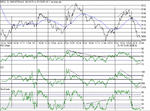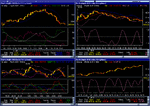Chart attached is to stimulate further analysis. It shows the correlation of RSI, CCI, 100MA, stochastics and the various potential entry and exit points. Notice also some of the divergences....
A basic criteria for long entry is RSI>50 and CCI>0; Short entry RSI<50 and CCI<0. If you read the TA books, they suggest CCI values of +/- 100 as entries for long/short. These I consider "safe" values and maybe +/- 50 would be a little more realisticly safe for the dow.
Test and refine your techniques on paper and see how you get on and remember that with CMC, the bid/offer typically moves ahead/behind by 10 points on strong moves, giving a minimum "win" move required of at least 30 points.
A basic criteria for long entry is RSI>50 and CCI>0; Short entry RSI<50 and CCI<0. If you read the TA books, they suggest CCI values of +/- 100 as entries for long/short. These I consider "safe" values and maybe +/- 50 would be a little more realisticly safe for the dow.
Test and refine your techniques on paper and see how you get on and remember that with CMC, the bid/offer typically moves ahead/behind by 10 points on strong moves, giving a minimum "win" move required of at least 30 points.





